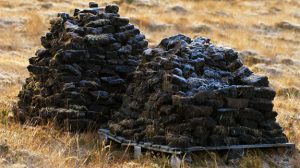
Peat Cut and Stacked for Drying
Pete – who is this guy and why does he make my Whiskey taste smoky?
Of course it’s not Pete rather peat and it is a frequent topic of discussion among Whiskey lovers and novices alike.
Peat is 100% natural in its composition and its formation. It is the accumulated layers of decaying organic material (grasses, small shrubs, and other vegetation found in your average meadow). Peat forms in wetlands where the buried dead vegetation does not fully decay due to a lack of oxygen creating anaerobic conditions.
Peat forms rather slowly at a rate of approximately one millimeter per year. A quick tap on the calculator reveals that peat bogs at a depth of three meters (typical in Ireland and Scotland) take 3,000 years to form.
In many places peat is still cut by hand but commercial peat operations employ machinery. While driving through the countryside in both Ireland and Scotland you will likely encounter peat bricks stacked in a rough pyramid shape in order to dry. Once cut from the ground the peat dries to a hardened brick in days or weeks depending on the conditions.
Whisky drinkers rightly associate peat and peat bogs with Ireland and Scotland but peat bogs are found in well over a 100 countries and are said to cover 3% of Earth’s land.
Whiskey can become influenced by peat when in the process of making malted barely the damp, just germinating grains of barely are dried with a peat field fire. The unique smoke aromas of the burning peat permeate the grains of malt. This smoky malt naturally flavors the fermented wash that is then distilled to a spirit that will become Whiskey (once aged in cask).
Peat is an assertive aromatic and flavor influencer. The perfect amount of “peatiness” is very subjective. Luckily there is a method of measuring the phenol content most often expressed in parts per million (ppm).
Whiskies from the Scottish Isle of Islay are among the peatiest Whiskies so much so that many Whisky drinkers assume that all Islay Whisky is peaty. Ardbeg is considered the most peaty followed by Laphroaig, Lagavulin, and Caol Ila (all Islay Whiskies). Talisker from Skye and Highland Park from Orkney exhibit a more subtle peat influence. Of course most Whiskies have no peat influence at all so if the smells of a roaring campfire are not your cup tea there is still a Whiskey for you.
If you are a fan of peaty Whiskey and you have a fireplace at home check out one of the several Irish peat briquettes available on the internet. These little bricks of peat will transport you to your favorite Irish pub on a cool winter’s night.
